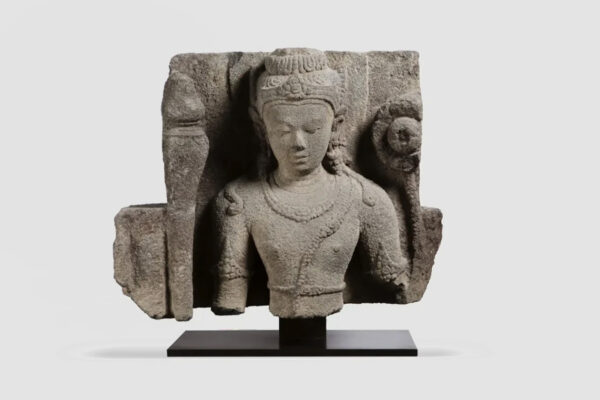Paintings and prints estimate
Do you own an Asian painting or print and want to know its value? Whether you’re a passionate collector or have a family heirloom, having your print or painting appraised is an essential step in understanding its true potential. Our Asian art experts will provide you with a free, confidential estimate within 48 hours, and will accompany you every step of the way, whether you wish to sell at auction or simply find out the value of your piece.
Estimates and prices of Asian paintings and prints
Asian paintings price table :
| Typology | Low estimate (EUR) | High estimate (EUR) |
|---|---|---|
| Portrait Paintings | 15,000 | 40,000 |
| Scenes from everyday life | 20,000 | 35,000 |
| Religious scenes (e.g. Bodhisattva, Buddha) | 5,000 | 25,000 |
| Symbolic animals (e.g. birds of prey, deer) | 2,000 | 15,000 |
| Paintings of Mandarins or Figures in Traditional Costumes | 10,000 | 30,000 |
| Landscape and flower paintings | 1,000 | 10,000 |
| Large horizontal compositions (e.g. multiple rolls) | 5,000 | 20,000 |
| Thangkas (Tibetan religious paintings) | 8,000 | 30,000 |
Price table for Asian prints :
| Print typology | Low estimate | High estimate |
|---|---|---|
| Individual prints (Edo/Meiji) | 10 € | 1000 € |
| Triptychs or series (Edo/Meiji) | 150 € | 3400 € |
| Lithographic posters | 60 € | 60 € |
| Print books (e.g. Watanabe Seitei) | 50 € | 300 € |
| Sets of several prints | 50 € | 4 800 € |
| Modern prints | 10 € | 60 € |
Why should I have my Asian painting or print appraised?
If you own an Asian painting or print and would like to know its value, you have several options for obtaining a reliable estimate:
There are several advantages to obtaining an accurate estimate for your painting or print:
For an auction: If you’re planning to sell your item, knowing its current value helps you set a fair and attractive price.
For insurance: In the event of a claim or damage, an estimate enables you to insure your room properly.
As part of an inheritance: If you have inherited a painting or print, you may need an appraisal for inheritance tax purposes or to divide the inheritance fairly.
Curiosity: You may simply want to know the value of your painting or print, especially if it’s an heirloom or family heirloom.

How to have your painting or print appraised with Asium?
Nothing could be simpler! You can request an estimate directly online via our form. Simply upload photos of your painting or print and add a description. Our experts will get back to you within 48 hours with a confidential estimate.
For larger collections or high-value objects, we also offer in-home appraisal services or the possibility of attending our appraisal days, where you can bring your coral for an in-person appraisal.
How to recognize an Asian painting or print?
It can be difficult to recognize a genuine Asian painting or print, but here are some criteria to consider:
- Materials and support: Traditional Asian paintings are often produced on silk or paper, usually mounted in rolls (horizontal or vertical). Japanese ukiyo-e prints are made on paper with woodblock impressions.
- Themes and motifs: Chinese and Japanese works frequently feature natural motifs (landscapes, mountains, flowers) and spiritual elements (dragons, phoenixes). Nature is represented in a poetic and symbolic way, while Japanese prints also explore urban life and portraits.
- Use of space and voids: Asian art values the balance between painted elements and empty spaces, creating visual harmony. This aesthetic of “emptiness” often reflects philosophical concepts, such as Japan’ s wabi-sabi, which celebrates imperfection.
- Ink and brush techniques: Asian paintings use ink wash techniques, with varied brushstrokes (often fluid or subtle) to represent movement and texture. Lines are generally fine and expressive, with particular attention to precision.
- Signatures and seals: Authentic Chinese and Japanese works often bear the artist’s signature, accompanied by red ink seals called hanko or chop. These seals indicate the identity of the artist or workshop, and may also bear poetic inscriptions or authentication marks.

How to recognize the value of an Asian painting or print
How to assess the value of your Asian painting or print
When you hold your Asian painting or print, there are several criteria that can help you determine its value. Here’s a detailed guide to help you value your object accurately:
Natural pigments and patina
Older works often use natural pigments derived from minerals, plants or organic elements, such as indigo or cinnabar. Over time, these colors can acquire a patina or slight tarnish, a sign of authenticity. In an ukiyo-e print, for example, Prussian blue may have faded slightly or taken on a softer hue, unlike modern works which often use bright synthetic inks.
Asymmetrical composition
Asian art often favors asymmetry, with off-center, dynamic compositions. This approach guides the eye through the work, offering a rich and often contemplative visual experience.
Religious and symbolic influences
Many Asian paintings and prints incorporate references to Buddhism, Taoism or Shintoism. Symbols such as the lotus, sacred mountains or mythological animals (like the tiger and the crane) convey deep spiritual meanings, rooted in local beliefs and traditions.
These criteria can be used to identify an authentic Asian painting or print, and to distinguish older pieces from those made more recently.

A brief history of Asian paintings and prints
The history of Asian paintings and prints in the art world goes back centuries, reflecting a rich diversity of styles, techniques and cultural traditions. In China, the art of painting on silk and paper rolls took shape as early as the Han and Tang dynasties, blending elements of landscapes, mythical figures and ideograms. The masters of the Song dynasty introduced more minimalist, nature-based compositions, having a lasting influence on Asian painting styles and marking a transition to more spiritual, introspective works.
In Japan, woodblock printing, known as ukiyo-e, emerged during the Edo period (1603-1868) and became a mainstay of Japanese art. Using engraved wooden blocks to produce mass-produced images, these works featured landscapes, scenes of daily life and portraits of famous figures.Ukiyo-e enjoyed international success in the 19th century, influencing European artists such as Van Gogh and Monet, and paving the way for a cultural fusion between East and West in art.
Today, Asian prints and paintings continue to captivate collectors and art lovers for their technical finesse and symbolic depth. Older works are highly sought-after on the art market, with some estimated at several hundred thousand euros. This success is due to the rarity and preservation of these often fragile pieces, but also to the growing interest in Eastern philosophy and aesthetics, which still resonate in contemporary art.
Our experts in paintings / prints
-

Eunbi HA
-

TaHsi CHANG
Specialist in the arts of VIETNAM and CHINA
-

Lucas TAVEL
Auctioneers & judicial commissioners
Your questions, our answers
What do you need to know to recognize an Asian painting or print?
To recognize Asian paintings or prints, you need to pay attention to materials and supports, themes and motifs, ink and brush techniques, as well as signatures and seals.
What is the price range for an Asian painting or print?
Auction prices for these items range from 10 to 4,000 euros.
Previously appraised by Asium
The Asium estimation service is...

Simple
and free
A few photos of your work, a few words of description and you're all set !

Fast
but not too fast
Our experts are serious, they take the time to research and get back to you within a week.

Reliable
and confidential
Our auctioneers are the Sherlock Holmes of the art market.































